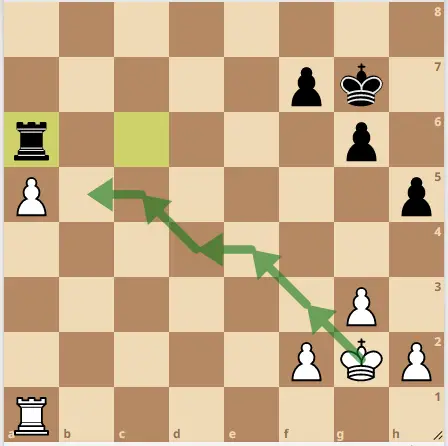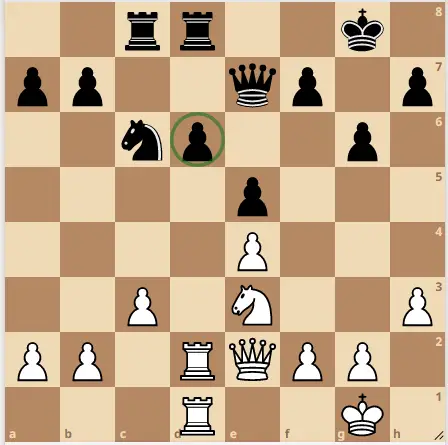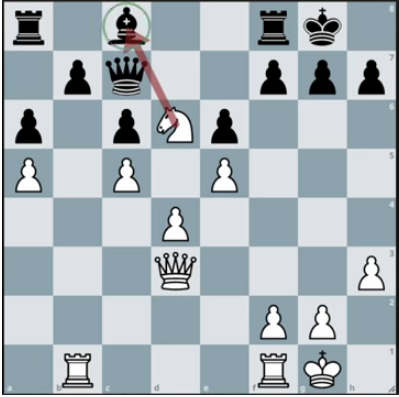There are 6 different types of chess pieces on the board: the king, queen, rook, bishop, knight and pawn. However, not all of them are created equal.
The power of a chess piece lies in the scope and the number of squares it control. The Queen is said to be the most powerful piece as it can move in any direction any number of squares. But many people want to know, “What is the second most powerful piece in chess?” Read on to find out what piece this is.
What Is The Second Most Powerful Piece In Chess?
The second most powerful piece in chess is the rook. The Queen has a value of 9 points, the rook 5 points, bishop 3 points, knight 3 points, and pawn 1 point. Therefore, the only piece that has more points than the rook is the queen.
The power of a piece is determined by the number of squares it can control on the chess board. The rook controls a total of 14 squares on the chess board. It moves vertically and horizontally in a straight line.
The rook is the second most powerful piece in chess as it controls 14 squares

No other piece on the chess board can move up, down and sideways like the rook except the Queen. The Queen not only moves vertically and horizontally, but it moves diagonally as well. This is why the rook will always be second to the queen.
When Is The Rook At Its Most Powerful?
Because rooks move up and down the chess board, they need open files to be at their most powerful. Files are the vertical rows lettered a through h of the chess board. According to the “principle of activity”, you should bring your pieces to their most active squares and that means placing your rooks on open files or semi-open files so that they move up and down the chess board freely.
The power of a rook increases on open files

In the position above, white’s rook is actively placed on the open e-file. There are no pawns on this file that will block the path of the white rook. Therefore the rook is very powerful on this file. Black will have a challenging time castling his king as it’s currently being attacked by the white rook down the e-file.
Pigs on the 7th rank
Rooks are powerful on open files, but they are at their most powerful whenever they occupy the 7th rank (2nd rank for black). Rooks on the 7th rank can also be referred to as “pigs on the 7th rank” because they have the ability to gobble up enemy pawns along that rank. In many cases, two rooks on the 7th rank is devastating enough to deliver checkmate to the opposing king.
For example, in the following game, the white rooks invaded black’s position and were able to capture all of black’s pieces along the 7th rank by continually threatening to checkmate the black king.
In what looked like a hopeless position for white, the two rooks on the 7th rank worked together by threatening checkmate while simultaneously capturing all of black’s pieces. This sequence of moves can be referred to as windmill, which is a rare tactical combination in chess.
When Is The Rook At Its Least Powerful?
Rooks are powerful on open files and on the 7th rank, but they are at their least powerful whenever they are locked behind their own pawns. In the starting position of a chess game, the rooks are at their least powerful as they are blocked by their own pawns and pieces.
Rooks in the corner have a hard time getting active

Rooks are one of the last pieces to develop in chess because they are placed so far in the corner of the chess board. It’s your responsibility to prioritize their development so that you can get the most out of the game. So how do you develop your rooks for maximum activity? Follow these steps below:
How To Activate/Increase The Power Of Your Rooks?
1. Castle
The best way to activate your rook in the opening stage of the game is to perform castling. Castling is a special move in chess that gets your king to safety. It’s a single move that involves both the king and the rook. When castling is achieved, the rook is brought out from the corner of the chess board and the king moves 2 squares closer to the corner where it is safely protected.
To perform castling, move your king 2 squares closer to the rook in the corner, then jump your rook over the king such that it lands beside it.
Before castling

After castling

Castling is the only time that 2 pieces are moved on a single turn. The rook can now take part in the game and is no longer passively placed in the corner.
2. Push Your Pawns And Exchange Them
After you castle your king, you need to open up files for your rooks, particularly the central files namely c, d and e files. To open files for your rooks, you need to advance your pawns forward and exchange them off in the center.
In fact, you can begin implementing this strategy even before castling. For example, in the Queen’s Gambit Declined Exchange variation opening, white usually opens up the c-file for his queenside rook as early as move 4.
cxd5 opens up the c-file for white’s queenside rook

White’s rook on a1 can now get active along the c-file

3 Strategies To Employ With Your Rooks
Apart from power, rooks are one of the most strategic pieces in chess as they can help to carry out a specific plan. Here are 3 strategic rook concepts you should know:
1. Rooks Belong Behind Passed Pawns
A passed pawn is a valuable asset to have in the endgame. Once it reaches to the last rank, it gets promoted to a queen or any other piece of higher value.
However, you can run into a few challenges when advancing your pawn down the file. It can get attacked by an enemy piece. Therefore, one of the best things you can do is to get your rook behind your passed pawn in order to protect and support it up the board.
Rooks belong behind passed pawns

In the following position, white should get his rook behind the passed pawn by playing the move rook to a1. Black would have to blockade this pawn with his rook.
However, by doing so, the black rook gets tied down to the defense of the passed pawn. White can use this distraction to execute other plans on the chess board, for example getting the white king to the other side of the board to help out with the promotion of the pawn.

2. Use Rooks To Attack Backward Pawn
A backward pawn is a weak pawn on a semi-open file that cannot be protected by another pawn. It cannot safely advance foward because the square in front is controlled by the opposing piece(s). The pawns that are left or right of the backward pawn have advanced forward down the board and cannot move backwards to protect over this weakness.
The diagram below shows an example of a backward pawn:

Whenever your opponent has a backward pawn like the one in the above diagram, double your rooks along the file that the backward pawn sits to pile on pressure onto it. Notice that black’s d6 pawn cannot safely advance forward because white’s pieces have complete control over the d5 square.
3. Staircase Checkmate Strategy
When it comes to checkmating the enemy king, your pair of rooks can carry out the job effectively. The best strategy to checkmate a lone king with your 2 rooks is to use the staircase method.
The idea is to push the enemy king towards the side of the board by taking away a file each move. If the King attacks your rook, swing it to the opposite side of the board and continue walking your rooks down the board step by step like a staircase.
When the king finally is pushed to the edge of the board, use your rook to deliver the final blow. The game below illustrates the staircase method.
The only other piece that can perform the staircase method is the queen. The ability for the rooks to support passed pawns up the board, attack backward pawns down the files and to deliver checkmate against the enemy king is the reason why they are one of the most powerful pieces on the chess board.
When The Knight Is More Powerful Than The Rook
In general, the rook is more powerful than the bishop and knight. However, just as in real life, not everything is set black and white. In some positions, the knight or bishop can be worth more than the rook.
Knight Stronger Thank Rook
A knight that is cemented on an uncontestable outpost in the opponent’s half of the board is sometimes more powerful than a rook. A knight on the 5th or 6th can be worth equivalent to a rook if not more.

For example, in the following position, the knight on d6 is extremely strong as it cannot be chased away from its outpost since there are no pieces on the dark squares to attack it. Black would have to sacrifice one of his rooks if he is to eliminate this knight from its outpost.
Final Verdict
The rook is the second most powerful piece in chess behind the queen. Because the rook is so powerful and valued, it is also vulnerable if it gets attacked by an opponent’s pawn or piece of lower value.
Rook are at their most powerful when placed on the 7th rank. They are also referred to as rescue pieces because they can deliver perpetual checks along the 7th rank to draw the game in a completely lost position.


